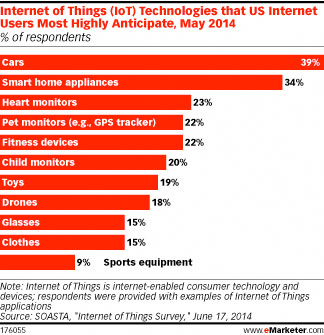Connecting the Dots: Consumers Mixed over Connected Future
July 30, 2014
![]() The premise of the internet of things (IoT)—that everything can and will be connected—is by turns enticing and intimidating. Who wouldn’t want the ability to cool a room before returning home or have the oven start to cook the evening meal remotely? What business wouldn’t want to keep closer, more up-to-the-minute tabs on inventory thanks to stock items that can communicate levels and whereabouts?
The premise of the internet of things (IoT)—that everything can and will be connected—is by turns enticing and intimidating. Who wouldn’t want the ability to cool a room before returning home or have the oven start to cook the evening meal remotely? What business wouldn’t want to keep closer, more up-to-the-minute tabs on inventory thanks to stock items that can communicate levels and whereabouts?
 On the other hand, the prospect of having to, in effect, “reboot” an entire home or warehouse when a virus strikes or the internet glitches is an unwelcome extension of the challenges consumers and enterprises already face daily with their various computing devices, according to a new eMarketer report, “Key Digital Trends for Midyear 2014: The Internet of Things, Net Neutrality, and Why Marketers Need to Care.”
On the other hand, the prospect of having to, in effect, “reboot” an entire home or warehouse when a virus strikes or the internet glitches is an unwelcome extension of the challenges consumers and enterprises already face daily with their various computing devices, according to a new eMarketer report, “Key Digital Trends for Midyear 2014: The Internet of Things, Net Neutrality, and Why Marketers Need to Care.”
A completely connected future, while increasingly within reach from a technological perspective, remains cloudy from the consumer standpoint. General awareness of the IoT is still low.
Consider the results of a May 2014 survey from SOASTA, a platform for performance testing websites and mobile apps. The survey found 73% of US adults were unfamiliar with the IoT, while only 6% of respondents described themselves as “very familiar” with it. However, when prompted with more details, 67% said they were excited about the promise of greater connectedness.
Enthusiasm about the prospective benefits of a more technology-driven future is a long-running theme that dates to the Industrial Revolution. Emblematic are the results of a March 2014 survey by Pew Research Center’s Internet Project in conjunction with Elon University’s Imagining the Internet Center. Some 1,606 technology experts and highly engaged US internet users were polled about whether they thought the IoT would have “widespread and beneficial effects on the everyday lives of the public by 2025.” A significant majority—83%—said yes.
But the road to that technology-centered future will be long. Thinking of just one small niche within the broader IoT landscape—the smart home—most US internet users (85.0%) did not own a single smart home device, according to a May 2014 AYTM Market Research survey. And of that group, over half expressed little interest in owning one.
“Consumers have pretty limited awareness of the internet of things as a concept, but there is enthusiasm for a future punctuated by a range of new, internet-connected devices and applications,” said Noah Elkin, executive editor at eMarketer. “As more name brands get into the game, from Apple and Google to big-box retailers like The Home Depot, Best Buy and Staples, just to name a few, expect consumer awareness to grow. Just don’t assume uptake will happen overnight.”
There is no standard definition for the “internet of things” (IoT). The term generally denotes an advanced level of networked connectivity between objects, platforms, systems and services that enables the exchange of data without human intervention. The premise behind the IoT is that any object, whether natural or manufactured, can gain the ability to transmit data over a network.
Courtesy of eMarketer






























